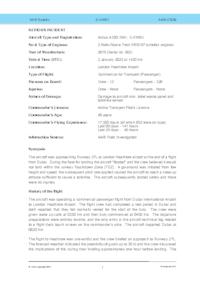
This information is added by users of ASN. Neither ASN nor the Flight Safety Foundation are responsible for the completeness or correctness of this information.
If you feel this information is incomplete or incorrect, you can submit corrected information.
| Date: | Sunday 2 January 2022 |
| Time: | 14:27 UTC |
| Type: |  Airbus A350-1041 |
| Owner/operator: | British Airways |
| Registration: | G-XWBC |
| MSN: | 362 |
| Year of manufacture: | 2019 |
| Engine model: | Rolls-Royce Trent XWB-97 |
| Fatalities: | Fatalities: 0 / Occupants: 338 |
| Other fatalities: | 0 |
| Aircraft damage: | Minor |
| Category: | Serious incident |
| Location: | London-Heathrow Airport (LHR/EGLL) -
 United Kingdom United Kingdom
|
| Phase: | Landing |
| Nature: | Passenger - Scheduled |
| Departure airport: | Dubai Airport (DXB/OMDB) |
| London-Heathrow Airport (LHR/EGLL) | |
| Investigating agency: | AAIB |
| Confidence Rating: |
British Airways flight BA104, an Airbus A350-1000 (G-XWBC) sufferered a tailstrike while landing on runway 27L at London-Heathrow Airport, UK.
There was damage to the aircraft skin, toilet waste panel and tail strike sensor. There were no injuries.
The aircraft was approaching Runway 27L at London Heathrow airport at the end of a flight from Dubai. During the flare for landing the aircraft “floated” and the crew believed it would not land within the runway Touchdown Zone (TDZ). A go-around was initiated from low height and speed; the subsequent pitch rate applied caused the aircraft to reach a nose-up attitude sufficient to cause a tail strike. The aircraft subsequently landed safely and there were no injuries.
Although the wind conditions at Heathrow were gusty, they were within limits for the approach. The approach was flown with the APs engaged until approximately 400 ft agl and then manually. The flare was initiated at 50 ft agl with the pitch attitude raised to 7° nose-up. This caused the rate of descent to reduce to 0 ft/min and so the aircraft floated along the runway. The thrust levers were retarded at 30 ft agl and the airspeed decreased with a concomitant reduction in lift. The aircraft then started to descend once more.
As the commander felt the aircraft would land beyond the TDZ, he directed a go-around in accordance with the operator’s policy. TOGA was selected on the thrust levers and, simultaneously, the co-pilot briefly applied full nose-up pitch control before partially reducing the command. This caused a pitch-up rate of approximately 3°/s. The aircraft touched down, and as the pitch attitude reached 9° nose-up the tail struck the ground.
The go-around was initiated before touchdown but as the engine thrust had been reduced to idle it took some seconds to develop go-around thrust. The airspeed had reduced significantly below approach speed and so the aircraft lacked the performance to gain height immediately and the touchdown resulted. This possibility is recognised in the FCTM which gives guidance for handling the aircraft in such circumstances.
From the point at which the go-around was initiated, 2,760 m of runway remained ahead of the aircraft, which would have been sufficient distance for the aircraft to land and safely decelerate. In these circumstances, it is unlikely that the control inputs that led to the significant pitch up would have been made and the aircraft might not have been damaged. However, landing would have been against the operator’s policy – common across all its fleets – to reject a landing if a touchdown beyond the defined TDZ is anticipated. The policy is applicable to a wide range of aircraft and airports, including many with restrictive runway lengths. The operator’s view was that a single policy ensures simplicity, avoids ambiguity, and includes a consideration that runway excursions represent a greater hazard than go-arounds.
AAIB Conclusion
A go-around was initiated from low height and low speed. The aircraft had insufficient energy to climb immediately and so touched down during the go-around process. The pitch rate induced by the co-pilot caused the aircraft to reach a nose up attitude sufficient to cause a tailstrike as the aircraft touched down.
METAR:
Weather reported about the incident time (14:27Z):
EGLL 021420Z AUTO 21013KT 9999 -RA BKN020/// BKN029/// //////CB 12/09 Q1008
EGLL 021520Z AUTO 24020G30KT 9999 FEW021/// BKN026/// BKN030/// //////CB 12/09 Q1008 TEMPO 4000 RA
Accident investigation:
 |
|
Sources:
1. AAIB Final Report: https://assets.publishing.service.gov.uk/media/62e925308fa8f5033906b7f4/Airbus_A350-1041_G-XWBC_09-22.pdf
2. https://www.flightglobal.com/safety/ba-a350-1000-struck-tail-during-go-around-after-prolonged-float/149896.article
3. https://www.flightradar24.com/data/aircraft/g-xwbc#2a5e7e9f
History of this aircraft
Other occurrences involving this aircraft
| 6 April 2024 | G-XWBC | British Airways | 0 | London-Heathrow Airport (LHR/EGLL) |  |
min |
| Collision with other aircraft on apron | ||||||
Media:
During a flight into London Heathrow Airport, an Airbus A350-1041 (G-XWBC) floated along the runaway, and the aircraft’s tail struck the ground during a go-around.
— AAIB (@aaibgovuk) August 18, 2022
Read the report: https://t.co/6l8PFxGxZH#AviationSafety pic.twitter.com/8bshEULjrf
Revision history:
| Date/time | Contributor | Updates |
|---|---|---|
| 04-Jan-2022 15:37 | Goklerdeyiz.net | Added |
| 04-Jan-2022 15:42 | harro | Updated [Time, Location, Source, Embed code, Narrative] |
| 18-Aug-2022 15:37 | Dr. John Smith | Updated [Total occupants, Other fatalities, Source, Embed code, Narrative, Category] |
| 18-Aug-2022 15:43 | Dr. John Smith | Updated [Embed code] |
| 18-Aug-2022 15:44 | Dr. John Smith | Updated [Embed code] |
| 18-Aug-2022 18:55 | harro | Updated [Source, Embed code, Narrative, Accident report] |
| 18-Aug-2022 18:56 | harro | Updated |
Corrections or additions? ... Edit this accident description
The Aviation Safety Network is an exclusive service provided by:


 ©2024 Flight Safety Foundation
©2024 Flight Safety Foundation